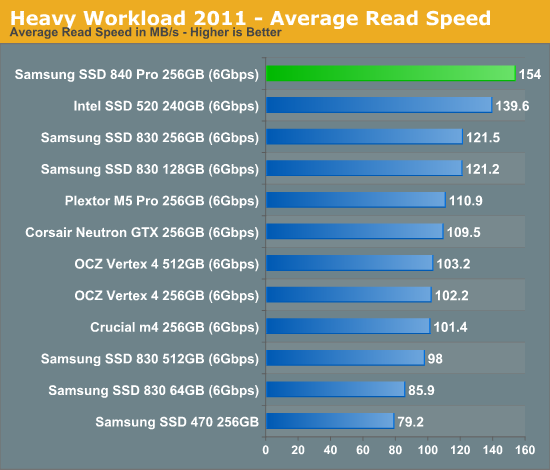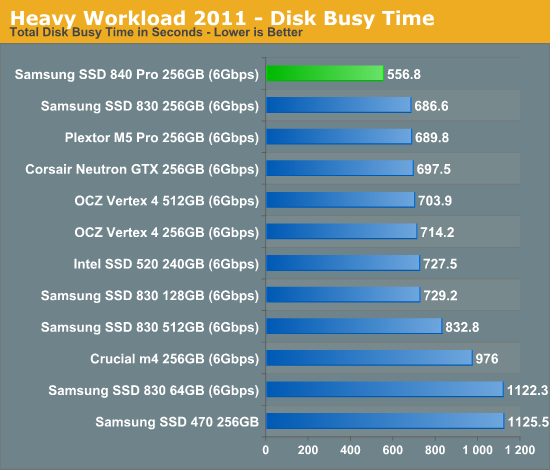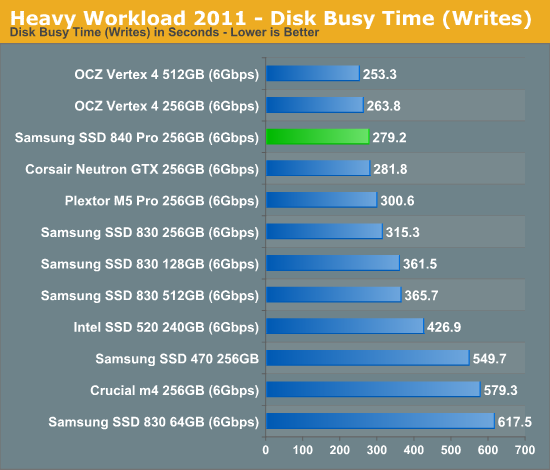Samsung SSD 840 Pro (256GB) Review
by Anand Lal Shimpi on September 24, 2012 7:00 AM EST- Posted in
- Storage
- SSDs
- Samsung
- Samsung SSD 840
AnandTech Storage Bench 2011
Two years ago we introduced our AnandTech Storage Bench, a suite of benchmarks that took traces of real OS/application usage and played them back in a repeatable manner. I assembled the traces myself out of frustration with the majority of what we have today in terms of SSD benchmarks.
Although the AnandTech Storage Bench tests did a good job of characterizing SSD performance, they weren't stressful enough. All of the tests performed less than 10GB of reads/writes and typically involved only 4GB of writes specifically. That's not even enough exceed the spare area on most SSDs. Most canned SSD benchmarks don't even come close to writing a single gigabyte of data, but that doesn't mean that simply writing 4GB is acceptable.
Originally I kept the benchmarks short enough that they wouldn't be a burden to run (~30 minutes) but long enough that they were representative of what a power user might do with their system.
Not too long ago I tweeted that I had created what I referred to as the Mother of All SSD Benchmarks (MOASB). Rather than only writing 4GB of data to the drive, this benchmark writes 106.32GB. It's the load you'd put on a drive after nearly two weeks of constant usage. And it takes a *long* time to run.
1) The MOASB, officially called AnandTech Storage Bench 2011 - Heavy Workload, mainly focuses on the times when your I/O activity is the highest. There is a lot of downloading and application installing that happens during the course of this test. My thinking was that it's during application installs, file copies, downloading and multitasking with all of this that you can really notice performance differences between drives.
2) I tried to cover as many bases as possible with the software I incorporated into this test. There's a lot of photo editing in Photoshop, HTML editing in Dreamweaver, web browsing, game playing/level loading (Starcraft II & WoW are both a part of the test) as well as general use stuff (application installing, virus scanning). I included a large amount of email downloading, document creation and editing as well. To top it all off I even use Visual Studio 2008 to build Chromium during the test.
The test has 2,168,893 read operations and 1,783,447 write operations. The IO breakdown is as follows:
| AnandTech Storage Bench 2011 - Heavy Workload IO Breakdown | ||||
| IO Size | % of Total | |||
| 4KB | 28% | |||
| 16KB | 10% | |||
| 32KB | 10% | |||
| 64KB | 4% | |||
Only 42% of all operations are sequential, the rest range from pseudo to fully random (with most falling in the pseudo-random category). Average queue depth is 4.625 IOs, with 59% of operations taking place in an IO queue of 1.
Many of you have asked for a better way to really characterize performance. Simply looking at IOPS doesn't really say much. As a result I'm going to be presenting Storage Bench 2011 data in a slightly different way. We'll have performance represented as Average MB/s, with higher numbers being better. At the same time I'll be reporting how long the SSD was busy while running this test. These disk busy graphs will show you exactly how much time was shaved off by using a faster drive vs. a slower one during the course of this test. Finally, I will also break out performance into reads, writes and combined. The reason I do this is to help balance out the fact that this test is unusually write intensive, which can often hide the benefits of a drive with good read performance.
There's also a new light workload for 2011. This is a far more reasonable, typical every day use case benchmark. Lots of web browsing, photo editing (but with a greater focus on photo consumption), video playback as well as some application installs and gaming. This test isn't nearly as write intensive as the MOASB but it's still multiple times more write intensive than what we were running in 2010.
As always I don't believe that these two benchmarks alone are enough to characterize the performance of a drive, but hopefully along with the rest of our tests they will help provide a better idea.
The testbed for Storage Bench 2011 has changed as well. We're now using a Sandy Bridge platform with full 6Gbps support for these tests.
AnandTech Storage Bench 2011 - Heavy Workload
We'll start out by looking at average data rate throughout our new heavy workload test:

A strong showing in all of our low level IO tests, with no drawbacks, results in 24% better performance than the 830 in our heavy workload. There's simply no faster drive than the 840 Pro.


The next three charts just represent the same data, but in a different manner. Instead of looking at average data rate, we're looking at how long the disk was busy for during this entire test. Note that disk busy time excludes any and all idles, this is just how long the SSD was busy doing something:













96 Comments
View All Comments
Pneumothorax - Monday, September 24, 2012 - link
While the 840 Pro kicks ass, I wonder if the 3bpc 840 is going to have less endurance while offering the same performance as the previous gen 830 drive... If that's the case buy them up while they're on sale in the next few months before they run out. Unless another SSD maker comes out with a drive that tops the 840 Pro, it's going to command a premium price per gb for some time.Pixelpusher6 - Monday, September 24, 2012 - link
I ended up buying a Samsung 830 about a year ago and I have absolutely loved it, fast performance plus rock stable. I might consider grabbing one of these when the price comes down a bit.I was wondering if say Samsung or any other SSD manufacturer didn't care about power consumption as much, and say clocked those 3 cortex A9 cores @ 700Mhz instead of 300, would 4k random performance increase significantly? Or are these SSDs mainly limited by firmware still even at 300Mhz, so increasing the clockspeed won't have much impact. What about if they added a 4th core instead of increase clock speed?
apmon2 - Monday, September 24, 2012 - link
I would be interested to see numbers for the 840 pro and other SSDs for random 4k read performance at high queue depth.On my Samsung 32Gb msata SSD I get about 60Mb/s of 4kb random read at queue depth of 1. However at e.g. queue depth of 10 I see random read rates of over 250Mb/s!
I don't know how typical hi depth 4kb random read are on desktop loads, but for server applications like e.g. databases it is pretty common.
frombauer - Monday, September 24, 2012 - link
... to replace my aging Intel 320 series (300GB). Just wondering if it will make a tangible (in my eyes) difference in day to day use, since I don't care about benchmarking. Maybe it will be better to pick up a cheaper 830 which is proven to be reliable... either way, the Intel will go to my PS3 since I'm pretty sure it will be nearly useless to sell in the used market.Old_Fogie_Late_Bloomer - Monday, September 24, 2012 - link
I'm kind of in a similar boat, kind of wanting to upgrade my desktop's 160GB 320 with a drive that's faster and a bit more spacious. I had paired it with a 64GB Samsung 830 to free up the space used by the memory swap file, but I probably wouldn't do that if I got a larger drive.I could probably use the 64GB drive for my Steam folder, but I'd still be left with the 160 GB 320, as well as another 40 GB 320...it's like, what would I use those drives for? I guess I could hang onto them for when I get around to building a Linux box...
FunBunny2 - Monday, September 24, 2012 - link
-- I had paired it with a 64GB Samsung 830 to free up the space used by the memory swap fileI've always wondered: a swap file gets hammered, so when partitioning a drive with some swap and some user file system, does leveling only happen *within* the user defined partition? Or does the controller (or varying by controller) level across devices without regard to partitions?
If not, then a sacrificial small drive as swap is much safer.
DanNeely - Monday, September 24, 2012 - link
WIth any modern SSD there's no correlation between where a file is located on the nand ships and the location the file system driver is telling the SSD to write to.Old_Fogie_Late_Bloomer - Monday, September 24, 2012 - link
I had thought about that as well, when I decided to move the swap file; I wish Windows would let you move the hibernate image file too, for the same reason. That being said, though...I'm just not that worried about it, anymore. I don't think swap files or even hibernating your computer are going to do your SSD in prematurely.iamezza - Monday, September 24, 2012 - link
There really wouldn't be any difference in day to day usage, unless you have some really out of the ordinary patterns. Most day to day stuff will hardly stress an SSD at all.Old_Fogie_Late_Bloomer - Monday, September 24, 2012 - link
Really? 'Cause I have to say I never felt that the 320 quite lived up to all the hype about SSDs. And the sequential read times of the 840 should be significantly higher than those of the 320, right? Meaning that your boot times, application load times, level load times, etc. should be noticeably faster?